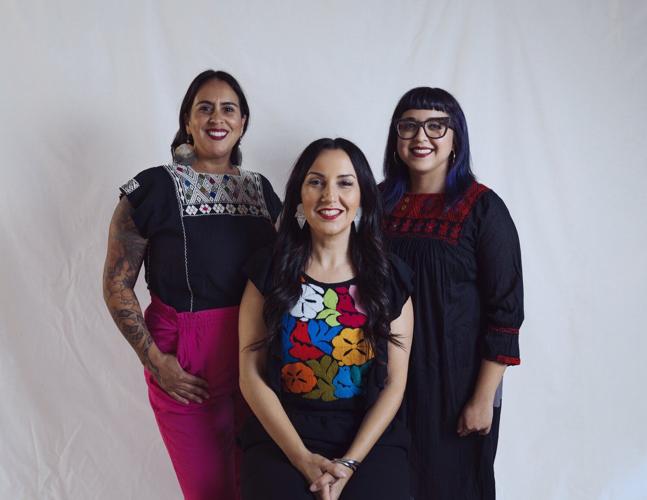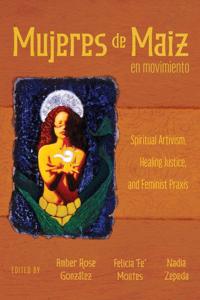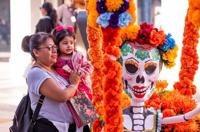
From left: Amber Rose González, Felicia 'Fe' Montes and Nadia Zepeda, the editors and members of Mujeres de Maiz and their new book "Mujeres de Maiz: En Movimiento." Photo courtesy of Mujeres de Maiz.
This is a busy year for Mujeres de Maiz, the spiritual artivist group. Not only will they be celebrating their 27th anniversary, they are also releasing a book that features essays, testimonies and poems, as well as works of art.
In a video conversation with members of the organization, the 'artivist' term was discussed as a combination of artists and activists. Mujeres de Maíz member Nadia Zepeda told CALÓ News it is a concept that originated from Gloria Anzaldua’s spiritual activism work.
“She was trying to make the connection between our spiritual practices, healing, our activist work and noting that they're not mutually exclusive, that they really work together,” Zepeda said. “A lot of the folks in the organization are artists and activists.”
Zepeda is a Chicana interdisciplinary scholar activist from Santa Ana, CA. She’s an assistant professor of Chicana/o Studies at California State University, Fullerton.
“It was an important term that we realized was just who we were already,” Mujeres de Maiz director Felicia ‘Fe’ Montes said. “Having deeply connected with our roots and ancestors and culture and art, and activism and artivism, seeing that term, it made sense to add art to the activism and spiritual activism.”
Montes is a Xicana Indigenous artist, activist, and community and event organizer living and working in the Los Angeles area. She is an assistant professor in Chicanx Latinx Arts and Social Practice at Cal State Long Beach.

"Mujeres de Maiz en movimiento" book cover. Photo courtesy of Mujeres de Maiz.
Their book is called "Mujeres de Maíz En Movimiento" and will be released with a live art show celebration on April 7. The live art shows and poetry readings have been a key part of the organization since its inception in 1997.
Mujeres de Maiz started as a poetry group, initially called In Lak Ech. Montes is one of the cofounders.
“We just saw the importance of sharing our stories as women and experiences, and how profound it was when either the audience or people heard their stories and saw themselves in art or poetry or pieces. And so we kept sharing. And then we decided to also organize an event, which was Mujeres de Maiz, and a 'zine,” Montes said.
Amber Rose González and Nadia Zepeda both came to live events of Mujeres de Maiz and then decided to work with the organization on each of their dissertations.
“I started organizing the live art shows and some of the programming and really, I would say, became like an activist scholar with Mujeres de Maiz and organizing and writing the dissertation about the organization and have been with them since,” González said.
Amber Rose González is a queer Apachicana (Apache/Mexican/Spanish descent) born and raised in the San Gabriel Valley, California and ancestrally rooted in New Mexico and Jalisco. She is an associate professor of ethnic studies at Fullerton College.
Zepeda has been working with Mujeres de Maiz since 2016, sharing that she has an interest in writing about the organization and Chicana feminist history in Los Angeles.
Many of their events are free and are created as a way to share information with people who are not as exposed to academic studies and scholarly discussions. “We've always talked about accessibility, to the type of information that we are sharing. So many of us connected with ethnic studies, or women's studies, or empowerment information, and empowering books and art, through school, through higher learning,” Montes said. “So if we're reading a book, what about all those people who never got to college, which is a majority of our communities? So how could we create an art piece or a hip hop song or a painting that way that we would share the same information or bits of the empowerment feeling to the community?”
Mujeres de Maiz sees art as an instrument to create community and share within the community, Montes continued. “We see art as a tool for education, empowerment and transformation. And so we could educate about a holiday or community event or historical event in a poem. Somebody could feel empowered by seeing something that they recognize or seeing another Brown woman in a painting, or a poem that was talked about in East L.A., South Central or something in their community back home, in the motherland. That is really what we started to share and create and why. To make it accessible.”
Montes said they will also do poetry processions in the streets, in an auto repair store or a nail salon. “We walk along the south side of [César] Chávez [Boulevard] and do that. So bringing it to not only the cultural centers and the books, but literally to the people or to high school assemblies in the schools,” Montes said.
González added that these types of accessible community events are also referred to as “nepantlera acts,” another term coined by Gloria Anzaldua. “It's really like translating through the embodiment, through the artivism … this is created in and by and for communities. Think about that bridge work that we do. And that long history, that genealogy of feminists of color doing that bridge work.”
Montes grew up with parents who were involved in the Chicano movement from the 60s and 70s but she wanted to focus her efforts on being more accessible through the arts. “My big difference is focusing on women, femme and gender nonconforming and queer communities, through the work of focusing on having them see themselves but also making things accessible to the new generation. So my focus has always been different from my parents' legacy,” she said.
Her focus on arts, wellness, spirituality, tne Indigenous and women contrast with the Chicano movement from the 60s and 70s which did not expand in these areas and in some cases it was “even detrimental to those communities at times, in terms of not representing them,” Montes said.
Montes shared that she became an artivist through her college studies. “If I was reading a paper and had to write a 20-page paper, for me, it was like how can I make it accessible with all the information I'm learning in school, or that I've lived and somebody else hasn't, so maybe it was a poem. For me it was mainly poetry and performance poetry at the time.”
Zepeda does not identify as an artivist, but as an artivist supporter. “I really see the importance of documenting our movements and documenting the work that has been done in Los Angeles and surrounding cities,” she said. “I came to the work around wellness and connections to ancestral indigenous knowledge.”
She agrees that art can be used as a vehicle to help our communities learn, but also “heal from the traumas and different experiences that we often encounter that cause harm. So, my entrada to this work has really been making those larger connections around how Mujeres de Maiz has really created this accessible [and] free space, that allows people to reconnect to their ancestors, reconnect to these lost knowledges, that are often happening because of assimilation, immigration, racist policies, that deter us from from these knowledges that are very much central to our communities.”
González expressed that she falls somewhere in between. “I'm also a supporter, I do do art, but not in this space. It's really interesting, I do other things.”
Her research focuses on cultural production.”For me, it's been really important to bring the work of Mujeres de Maiz and do the reverse almost, and bring it to my students who haven't had access to the community spaces.”
She helped organize a fashion show in Santa Barbara at La Casa de la Raza which she said is the “only Latinx, Chicanx cultural center” in that city. “Having the students learn how to organize, how to promote an event and how to basically curate an artivist event "has been her way of supporting and promoting the work that Mujeres de Maiz does for the community."
Their event, Mujeres de Maíz En Movimiento’ is set to bring to one stage the writings, work and women of Mujeres de Maiz, including performances by Dr. Martha E. Gonzalez (Quetzal), "pláticas y palabras" (panels), prayer and poetry remixed into one event, along with the release of the anthological book documenting the deep decades-long herstory of Mujeres de Maiz.
The work of Mujeres de Maiz is made possible in part by the generosity of patrons like The Andrew W. Mellon Foundation, their Humanities in Place program and grant of $600,000. With this funding Mujeres de Maiz is able to launch Rooted and Rising: Cultivating a Movement Milpa, which is a three-year project which will center on building solid organizational infrastructure, responding to demographic needs and systematizing Mujeres de Maiz's programming.
Mujeres de Maiz (women of the corn) was founded in 1997 as a grassroots, multimedia women’s activist organization based in East Los Angeles, California.
They regularly collaborate with women artists and educators of African, Central and South American, Jewish, Filipina, Asian, Native American and Sri Lankan descent.
Mujeres de Maíz en Movimiento will take place on April 7 from 5 to 8pm in Boyle Heights at The Flor y Canto Center, 2900 Calle Pedro Infante, Los Angeles, CA 90063.













(0) comments
Welcome to the discussion.
Log In
Keep it Clean. Please avoid obscene, vulgar, lewd, racist or sexually-oriented language.
PLEASE TURN OFF YOUR CAPS LOCK.
Don't Threaten. Threats of harming another person will not be tolerated.
Be Truthful. Don't knowingly lie about anyone or anything.
Be Nice. No racism, sexism or any sort of -ism that is degrading to another person.
Be Proactive. Use the 'Report' link on each comment to let us know of abusive posts.
Share with Us. We'd love to hear eyewitness accounts, the history behind an article.